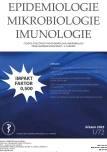Characteristics of the ID-NOW™ test for the rapid detection of SARS-CoV-2
Authors:
Z. Kepka; A. Briksi; P. Hubáček
; M. Zajac; P. Dřevínek
Authors place of work:
Ústav lékařské mikrobiologie 2. lékařské fakulty Univerzity Karlovy a Fakultní nemocnice v Motole, Praha
Published in the journal:
Epidemiol. Mikrobiol. Imunol. 72, 2023, č. 1, s. 3-8
Category:
Původní práce
Summary
Objective: To determine the sensitivity and specificity of the Abbott ID-NOW™ test in the diagnosis of COVID-19. The test is based on the detection of the SARS-CoV-2 gene by isothermal amplification technology.
Methods: From 303 individuals, two nasopharyngeal swabs and one oropharyngeal swab were collected to be tested in parallel by the ID-NOW™ test and PCR test (Allplex™ SARS-CoV-2 Assay). A subgroup of 107 individuals presented to the public collection point for covid-19 at the Motol University Hospital during the dominance of the Delta variant, and the others were tested via the Adult Emergency Admission Department during the dominance of the Omicron variant.
Results: Of 297 valid samples, 43 were positive by the PCR assay and 33 were positive by the ID-NOW™ test (sensitivity 76.74%; 95% CI 61.37 to 88.24%). ID-NOW™ detected three samples as positive, but the positivity was not confirmed by PCR (specificity 98.82%; 95% CI 96.59 to 99.76%). A significant increase in sensitivity up to 100% is observed for samples with a higher viral load (with a PCR threshold cycle value below 30 or from patients with symptoms of COVID-19). The Delta or Omicron variant has no significant effect on the sensitivity of the test.
Conclusion: Due to its ease of use and speed of result, ID-NOW™ is a suitable diagnostic tool for prompt assessment of a patient’s infectivity. If, despite the negative ID-NOW™ result, the patient has symptoms of COVID-19, it is advised to perform a classic PCR test for SARS-CoV-2.
Keywords:
POCT – sensitivity – SARS-CoV-2 – ID-NOW™
Zdroje
1. Onemocnění aktuálně: COVID19: Přehled aktuální situace v ČR [online]. 2022-07-08 [cit. 2022-07-08]. Dostupné na www: <https://onemocneni-aktualne.mzcr.cz/covid-19>.
2. World Health Organization. Recommendations for national SARS - -CoV-2 testing strategies and diagnostic capacities [online]. 2021 - 06-25 [cit. 2022-03-24]. Dostupné na www: <https://www.who. int/publications/i/item/WHO-2019-nCoV-lab-testing-2021. 1-eng>.
3. Ministerstvo zdravotnictví ČR. Vybrané indikátory stavu a šíření epidemie a denní souhrn testů na COVID-19 k 03. 02. 2022 [online]. 2022-02-03 [cit. 2022-07-30]. Dostupné na www: <https://www. mzcr.cz/tiskove-centrum-mz/vybrane-indikatory-stavu-a-sireni - epidemie-a-denni-souhrn-testu-na-covid-19-k-3-2-2022/>.
4. Arshadi M, Fardsanei F, Deihim B, et al. Diagnostic Accuracy of Rapid Antigen Tests for COVID-19 Detection: A Systematic Review With Meta-analysis. Front Med, 2022;9 : 870738.
5. Dřevínek P, Hurych J, Kepka Z, et al. Citlivost testů antigenu SARS-CoV-2 z hlediska testování ve velkém měřítku. Epidemiol Mikrobiol Imunol, 2021;70(3):156–160.
6. Maples BK, Holmberg RC, Miller AP, et al. Nicking and Extension Amplification Reaction for the Exponential Amplification of Nucleic Acids [online]. 2009 [cit. 2022-07-30]. Dostupné na www: <https://patents.google.com/patent/US9689031B2, US20140072978A1. U.S. Patent >.
7. Stürenburg E, Junker R. Point-of-Care Testing in Microbiology. Dtsch Arztebl Int, 2009;106(4):48–54.
8. Sepulda JL, Abdulbaki R, Sands Z, et al. Performance of the Abbott ID NOW rapid SARS-CoV-2 amplification assay in relation to nasopharyngeal viral RNA loads. J Clin Virol, 2021;140 : 104843.
9. Ramachandran A, Noble J, Deutcher A. Performance of Abbott ID‐Now rapid nucleic amplification test for laboratory identification of COVID‐19 in asymptomatic emergency department patients. J Am Coll Emerg Physicians Open, 2021; 2(6):e12592.
10. Barnacle JR, Houston H, Baltas I, et al. Diagnostic accuracy of the Abbott ID NOW SARS-CoV-2 rapid test for the triage of acute medical admissions. J Hosp Infect, 2022;123 : 92–99.
11. Patel MR, Carroll D, Ussery E, et al. Performance of Oropharyngeal Swab Testing Compared With Nasopharyngeal Swab Testing for Diagnosis of Coronavirus Disease 2019 – United States, January 2020–February 2020. Clin Infect Dis, 2021;72(3):403–410.
12. Srivastava S, Singh P, Malhotra R, et al. Comparison of Abbott ID NOW, a novel isothermal amplification based COVID-19 diagnostic method with RTPCR. J Virol Methods, 2022;304 : 114521.
13. van Kampen JJA, van de Vijver DAMC, Fraaij PLA, et al. Duration and key determinants of infectious virus shedding in hospitalized patients with coronavirus disease-2019 (COVID-19). Nat Commun, 2021;12(1):267.
14. Jaafar R, Aherfi S, Wurtz N, et al. Correlation Between 3790 Quantitative Polymerase Chain Reaction–Positives Samples and Positive Cell Cultures, Including 1941 Severe Acute Respiratory Syndrome Coronavirus 2 Isolates. Clin Infect Dis, 2021;72(11):e921.
15. Scheiblauer H, Filomena A, Nitsche A, et al. Comparative sensitivity evaluation for 122 CE-marked rapid diagnostic tests for SARS-CoV-2 antigen, Germany, September 2020 to April 2021. Euro Surveill, 2021;26(44):2100441.
16. Avanzato VA, Matson MJ, Seifert SN, et al. Case Study: Prolonged Infectious SARS-CoV-2 Shedding from an Asymptomatic Immunocompromised Individual with Cancer. Cell, 2020;183(7):1901 – 1912.e9
17. Kemp SA, Collier DA, Datir RP, et al. SARS-CoV-2 evolution during treatment of chronic infection. Nature, 2021;592(7853):277–282.
18. World Health Organization. Diagnostic testing for SARS-CoV-2 Interim guidance [online]. 2020-09-11 [cit. 2022-08-01]. Dostupné na www: <https://www.who.int/publications/i/item/ diagnostic-testing-for-sars-cov-2 >.
19. Kortüm S, Krause M, Ott HJ, et al. Molecular point-of-care testing for SARS-CoV-2 using the ID NOW™ System in Emergency Department: Prospective Evaluation and Implementation in the Care Process. MedRxiv [online] 2021-09-13. [cit. 2022-08-01] Dostupné na www: <https://www.medrxiv.org/content/10.1101/2 021.09.09.21263266v1.full.pdf+html >.
Štítky
Hygiena a epidemiológia Infekčné lekárstvo MikrobiológiaČlánok vyšiel v časopise
Epidemiologie, mikrobiologie, imunologie

2023 Číslo 1
- Parazitičtí červi v terapii Crohnovy choroby a dalších zánětlivých autoimunitních onemocnění
- Očkování proti virové hemoragické horečce Ebola experimentální vakcínou rVSVDG-ZEBOV-GP
- Koronavirus hýbe světem: Víte jak se chránit a jak postupovat v případě podezření?
Najčítanejšie v tomto čísle
- Črevná mikrobiota, jej vzťah k imunitnému systému a možnosti jej modulácie
- Multilocular infection caused by hypervirulent Klebsiella pneumoniae
- Zvláštnosti Q horečky a dosud zaznamenané humánní případy v České republice
- Charakteristika testu ID-NOW™ určeného k rychlé detekci SARS-CoV-2
